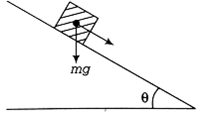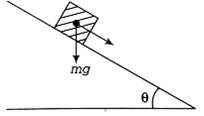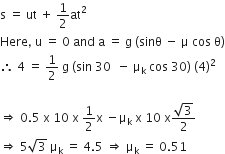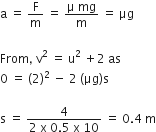A particle covers half of its total distance with speed v1 and the rest half distance with speed v2. Its average speed during the complete journey is
v1v2 / v1 + v2
2v1v2/v1 + v2
2v12v22 / v12 + v22
2v12v22 / v12 + v22
B.
2v1v2/v1 + v2
Velocity v = s / t
s = vt
The average speed of particle
A plank with a box on it at one end is gradually raised about the other end. As the angle of inclination with the horizontal reaches 30o, the box starts to slip and slides 4.0 m down the plank in 4.0 s. The coefficients of static and kinetic friction between the box and the plank will be respectively

0.6 and 0.6
06 and 0.5
0.5 and 0.6
0.4 and 0.3
B.
06 and 0.5
Given a plank with a box on it one end is gradually raised about the end having angle of inclination is 300, the box starts to slip and slides down 4 m the plank in 4 s as shown in a figure.
The coefficient of static friction.![]()
So, distance covered by a plank,
Thus, coefficient of kinetic friction between the box and the plank is 0.51
A conveyor belt is moving at a constant speed of 2 m/s. A box is gently dropped on it. The coefficient of friction between them is μ = 0.5. The distance that the box - will move relative to belt before coming to rest on it taking
g= 10 ms-2 is
1.2 m
0.6 m
zero
zero
D.
zero

Three blocks will masses m, 2m and 3m are connected by strings, as shown in the figure. After an upward force F is applied on block m, the masses move upward at constant speed v. What is the net force on the block of mass 2m? (g is the acceleration due to gravity)
zero
2 mg
3 mg
3 mg
A.
zero
Since all the blocks are moving with constant velocity, then the net force on all blocks will be zero.
A uniform force of (3 i + j) N acts on a particle of mass 2 kg. Hence the particle is displaced from position (2 i + k) m to position ( 4 i + 3 j - k) m. The work done by the force on the particle is,
9 J
6 J
13 J
13 J
A.
9 J
Given,
Force, F = 3 i + j
r1 = ( 2 i + k) m
r2 = (4 i + 3 j - k) m
Therefore,
S = r2 - r1

Therefore,
W = F. s
= (3i + j). (2 i +3j - 2k)
= 3 x2 + 3x0
= 6 + 3 = 9 J
